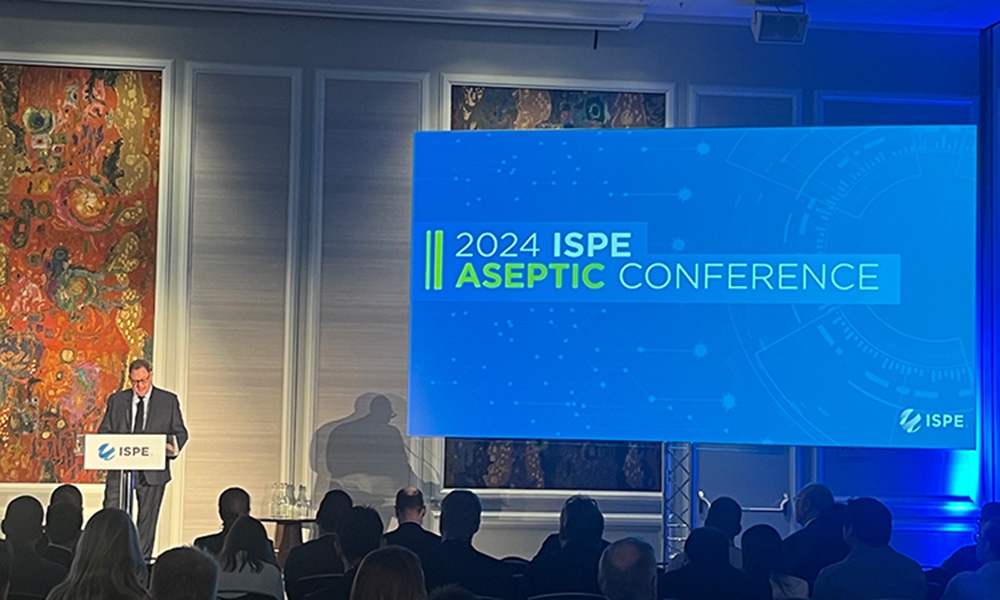Inspiring Keynotes from Day 2 of 2017 ISPE Annual Meeting & Expo

DAY 2 WRAP UP!
Incoming Board of Directors Chair Timothy Howard, Vice President, Commissioning Agents, Inc., opened day two of the 2017 ISPE Annual Meeting & Expo by thanking delegates for their attendance. “Whether this is your first annual meeting or your 31st,” he said, “I encourage each of you over the next three days to learn, to network, to collaborate, to influence and innovate, and to lead.” He concluded by introducing Roger Connor, President, Global Manufacturing and Supply, GlaxoSmithKline (GSK), who delivered the morning’s first keynote: “Bringing the Outside In: How Inspiration from Outside Pharma Can Transform Our Approach to Manufacturing.”
Innovation in Manufacturing
“I love what I do,” Connor told the delegates. “I love what I do,” he repeated, “but I have a problem: I don’t think we innovate enough in how we manufacture and supply our products.”
We’ve been making tablets the same way for hundreds—actually, for thousands—of years, he said. The first tablet press was patented in 1843. Active Pharmaceutical Ingredient (API) manufacturing is more complicated, but is still an incredibly wasteful process.
“I challenge to us do something different. I want to set a new vision for what manufacturing innovation can be. We must learn from other companies, smaller companies.”
Four key trends are driving the need for innovation in manufacturing, Connor said: improve access to medicines, restore trust, adapt to product complexity, and ensure higher standards. “If we use manufacturing innovation to address these, the difference would be absolutely massive.”
He then went on to ask, “Which companies are most ready for the next industrial revolution? Who’s leading the way? Who’s setting the standard? No pharma company is ready. We need leadership to set the ambition and the goal.”
How can we do this? “Bring the outside in. Go to innovators to find solutions.”
GSK’s approach is to “seek, incubate, and industrialize.” The company has dedicated professionals called “seekers,” whose job is to go outside the company and find new technology.
One of the new technologies currently in the “incubation” phase is a virtual reality-learning zone for GSK operators, a development that came from gaming technology. “Operators can go and practice there,” Connor said. “It’s a safe place—they’re not on the line. They’re working virtually.”
GSK also challenged its seekers to help reengineer inhaled medications. “Pollen is one of the most aerodynamically optimized particles in the world,” Connor said. “Can we take an API particle and shape it like pollen?” They could—by partnering with biopharmaceutical company Liquidia Technologies to create uniform pollen-shaped particles from molds created with etched silicon wafers. This technology is in phase 1, Connor noted, and still some years away from production. “But if they can be efficiently aerosolized into the lung,” he said, those particles will be twice as efficient as any other. This is the sort of thinking we have to do to create the intervention and paradigm shift that will change our industry.”
Pit Stops and Big Data
From the Formula One racing industry they learned to combine a pit-stop mentality with a big data approach. One production line, for example, would sometimes turn out asthma inhalers with a leak defect. “We asked McLaren Racing to see if they could solve it, and it turned out the inhalers’ crimping heads were the source of the problem.” GSK now collects 3.5 million data points on each batch, explained Connor. “We’re using McLaren to catalyze that improvement. It was cheap compared to consultants. That’s the sort of innovation I love.”
From the petrochemicals industry they use a pump that drives the production of 3 metric tons of material, but draws a similar electrical current to a 200-watt light bulb. Connor also showed the audience a microreactor that he called “the key to the future of continuous manufacturing. This is how we will change the way we operate.” GSK will use continuous reactors in a Singapore facility that will manufacture three metric tons of API in one room—instead of a multistory building. This has reduced water use and building footprint by 90%, lead time to manufacture a product dropped by 75%, and the cost of goods decreased by up to 30%.
“What’s stopping us as an industry from making this happen?” he asked. “First, you must have a vision. It can’t be my vision or global manufacturing’s vision. It has to be the company’s vision. It has to be jointly agreed to and be resourced to achieve it.”
Companies, most of which are risk averse, must also commit to the new technology. Some companies continue to run the old technology as a backup—and that quickly becomes a life raft that everyone jumps into at the first sign of a hurdle. “Take the life rafts away and it will succeed. But you have to stay strong and be courageous,” Connor advised.
Pharmaceutical manufacturing is critical, he said, and everyone has a responsibility to the person at the end of the supply chain. It’s essential that they know what they make and who takes it. It’s not just a package or a powder. Someone will inject or digest it.
“It’s time for the industry to step up,” he concluded. “Time to get out more. Time to innovate the manufacturing process of the future. If we do, not only will we deliver for the person at the end of the supply chain, we will become an example for all other industries. Maybe someday they’ll call us for help and inspiration.”
Innovating for a Cure
ISPE CEO and President John Bournas introduced the second keynote speaker, Glenn Pierce, MD, PhD, World Federation of Hemophilia Board of Directors Member and former Senior Vice President, Hematology, Biogen, Inc. Pierce’s address was titled “Innovation in Hemophilia: From Blood to Genes, and the Unintended Consequences Along the Way.”
“I am the patient at the end of the supply chain,” said Dr. Pierce. “I was born with severe factor VIII deficiency (the genetic disorder hemophilia A or classic hemophilia).” Hemophilic patients have little thrombin generation and form weak, friable clots that lead to prolonged bleeding. Internal bleeding in joints and muscles is common, as are life-threatening intracranial and intraabdominal bleeds.
Hemophilia is relatively rare, said Dr. Pierce. In the United States, there are about 20,000 individuals with factor VIII deficiency, while another 4,000 have factor IX deficiency, or hemophilia B. About 70% of the world’s hemophilia patients are untreated.
Treatments for hemophilia began in World War II with fresh frozen plasma, which provided a modicum of clotting factor—enough to have a modest effect. In the 1960s, American scientist Judith Graham Pool discovered cryoprecipitate, which helped produce therapeutic levels of factor VIII and revolutionized the care of hemophilia A. While these early treatments helped, they still allowed for massive accumulation of blood and subsequent crippling arthropathy.
Improved purification technologies, including monoclonal antibody (mAb) columns, led to 99%-pure factor VIII and IX by the late 1980s, but many of these factors were contaminated with hepatitis and HIV through the first half of the 1980s. Recombinant DNA and plasma-derived clotting factor concentrates in the 1990s allowed for prophylaxis regimens to prevent bleeding. Extended half-life (EHL) products emerged in 2014, and these reduced the number of infusions needed. Therapeutically effective gene therapies first showed results in 2015.
These products have changed the way hemophilia is treated, said Dr. Pierce. “Soon, instead of clotting factor peaks and troughs, we may have products that can maintain a more constant amount of therapeutic clotting activity.”
Displaying a series of photographs, Dr. Pierce documented the ravages of hemophilia over the past 100 years, from Tsarevich Alexei of Russia in the early 20th century to himself in the 1950s, and a young boy in Kenya in 2016. The photos represented “an uneven disbursement of technological innovations that have helped so many in the United States and Europe,” he said.
“The industry’s role as a manufacturer hasn’t always been pretty,” commented Dr. Pierce. “We were promised that plasma-derived products would be cheap and plentiful, but they haven’t been. Today, a cure really is five years away, but we’ve left the rest of the world behind.”
The bioengineered pipeline has products in various stages of clinical and preclinical testing. Emicizumab, currently in priority review, is a bispecific antibody that promotes factor X activation and accelerates coagulation. Clinical results showed that bleeds dropped by 87%. “Given weekly, emicizumab provides factor VIII-like results,” said Dr. Pierce. “This is a 24/7 concept of maintaining levels, with no peaks or troughs.”
On the horizon, gene therapy shows tremendous potential, “but there’s a lot we don’t understand about the process.
“The cure is upon us,” said Dr. Pierce, but the question is, “will people use it? There are long-term risks associated with gene therapy. We haven’t had it for a long enough time to know what they are.”
It is also an incredibly disruptive therapy that will replace other treatments. “Companies seem unable to innovate to replace the products that they have,” noted Dr. Pierce. “New EHL products and mAbs are coming from new companies. All innovation has originated in the entrepreneurial space.”
For now, he concluded, 15% of the world (North America and Europe) uses 70% of the product made, and 85% uses 30%. In 2016, 57 countries had no treatments at all. Dr. Pierce’s former company, Bioverativ, as well as SOBI, was the lead group that donated 500 million unites of clothing factor worth $1.5 billion to the World Federation of Hemophilia. Why did they do this?
“It was the right thing to do and it didn’t cost that much,” said Dr. Pierce. “That’s important to remember.”



